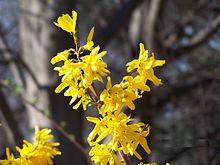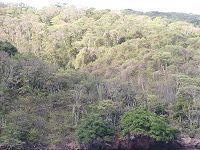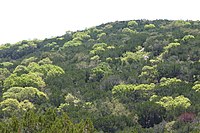Deciduous
In horticulture and botany, the term deciduous (from the Latin cadūcus (deciduous, fallen) and folĭum (leaf), deciduous leaf or decidua (from English deciduous) means "falling off at maturity" and "with a tendency to fall off", referring to trees and shrubs that shed leaves seasonally, usually in the fall; to the detachment of petals, after flowering; and to the shedding of ripe fruits. The antonym of deciduous in the botanical sense is evergreen.
In general, the term "expired" means "the fall of a part that is no longer necessary or useful" and the "fall after its purpose is finished". In plants, it is the result of natural processes. "Deciduous or deciduous" it has a similar meaning when referring to animal parts, such as the deciduous antlers of deer, deciduous teeth (milk teeth) in some mammals (including humans); or decidua, the uterine lining that is shed after birth.
Botany
In botany and horticulture, deciduous plants, including trees, shrubs, and perennial herbaceous plants, are those that lose all their leaves during part of the year. This process is called abscission. In some In most cases, leaf loss coincides with winter, that is, in temperate or polar climates. In other parts of the world, including tropical, subtropical, and arid regions, plants lose their leaves during the dry season or other seasons, depending on the seasons. variations in rainfall.
The opposite of deciduous is perennial, where the foliage falls at a different time than deciduous plants, so it appears to stay green all year because not all leaves fall at the same time. Plants that are intermediate may be called semideciduous; they shed old foliage as new growth begins. Other plants are semi-evergreen, losing their leaves before the next growing season, retaining some during winter or dry periods.
Many deciduous plants flower during the leafless period, as this increases pollination efficiency. The absence of leaves improves wind pollen transmission for wind-pollinated plants and increases flower visibility to insects in insect-pollinated plants. This strategy is not without risk, as the flowers can be damaged by frost or, in dry season regions, cause water stress in the plant.
The conditions that cause leaf bloom or leaf redness in spring can vary depending on the plant species or genus. Most herbaceous perennials and some woody plants are activated by warming air or soil temperature, for example, birches (Betula) and willows (Salix) will attempt to send flowers or leaves if there are some days where the ambient air temperature is higher than 50°F (10°C). This strategy is risky, as a fresh blast of cold air can freeze new growth. Other woody plants, such as oaks, walnuts, and walnut trees, develop leaves based on photoperiod, which means they wait until the day is long enough. These tend to be plants that have frost intolerant foliage, so leaves are delayed until late spring when danger of frost has largely passed.
Leaf fall in the fall months is based on photoperiod and varies by genus and species. Walnuts tend to drop their leaves early, while some trees such as Norway maples and willows have extremely late leaf drop, often in mid-November.
Leaf drop or abscission involves complex physiological signals and changes within plants. The photosynthesis process constantly degrades the supply of chlorophylls in the foliage; plants normally replenish chlorophylls during the summer months. When autumn arrives and the days are shorter or when plants are stressed by drought, deciduous trees decrease the production of chlorophyll pigment, allowing other pigments present in the leaf to become evident, thus results in foliage that is not green in color. The brightest leaf colors occur when the days shorten and the nights are cool, but remain above freezing. These other pigments include carotenoids which are yellow, brown, and orange. Anthocyanin pigments produce red and purple colors, although they are not always present in the leaves. Rather, they are produced on the foliage in late summer, when the sugars become trapped in the leaves after the abscission process begins. The parts of the world that have striking displays of brilliant fall color are limited to places where the days become short and the nights cool. In other parts of the world, the leaves of deciduous trees simply fall off without changing the brilliant colors produced by the buildup of anthocyanin pigments.
The beginning of leaf drop begins when an abscission layer forms between the petiole of the leaf and the stem. This layer forms in the spring during active new leaf growth; consists of layers of cells that can be separated from each other. The cells are sensitive to a plant hormone called auxin that is produced by the leaf and other parts of the plant. When auxin from the leaf is produced at a rate consistent with that of the plant body, the cells of the abscission layer remain connected; in autumn, or under stress, auxin flow from the leaf slows or stops, causing cell elongation within the abscission layer. The elongation of these cells breaks the connection between the different cell layers, allowing the leaf to separate from the plant. It also forms a layer that seals the break, so the plant doesn't lose sap.
Some trees, particularly oaks and beeches, exhibit a behavior known as "marcescence" whereby the dead leaves are not shed in the fall and remain on the tree until the weather blows them away. This is caused by the incomplete development of the abscission layer. It is mostly seen at the seedling and sucker stage, although mature trees may have marcescent leaves on the lower branches.
Several deciduous plants remove nitrogen and carbon from foliage before they shed and store them as proteins in vacuoles of parenchyma cells in the roots and inner bark. In the spring, these proteins are used as a nitrogen source during the growth of new leaves or flowers.
Function
Plants with deciduous foliage have advantages and disadvantages compared to plants with evergreen foliage. Since deciduous plants shed their leaves to conserve water or to better survive winter weather conditions, they must regrow new foliage during the next suitable growing season; this uses up resources that evergreens do not need to expend. Evergreens suffer greater water loss during the winter and may also experience greater predation pressure, especially when small. Deciduous trees experience much less branch and trunk breakage from freezing ice storms when leafless, and plants can reduce water loss due to reduced liquid water availability during cold winter days.
Winter leaf loss can reduce insect damage; repairing leaves and keeping them functional can be more expensive than simply losing them and growing them back. Removing leaves also reduces cavitation that can damage xylem vessels in plants. This allows deciduous plants to have xylem vessels with larger diameters and therefore a higher rate of transpiration (and, as a result, CO2 uptake, as this occurs when stomata are open) during the summer growth period.
Deciduous woody plants
The deciduous characteristic has developed repeatedly among woody plants. Trees include maples, many oaks and nothofagus, elms, beeches, poplars, and birches, among others, as well as several genera of conifers, such as larches and Metasequoia. Deciduous shrubs include honeysuckle, viburnum, and many others. Most temperate woody vines are also deciduous, including grapevines, poison ivy, Virginia creeper, wisteria, etc. The feature is useful in plant identification; for example, in parts of southern California and the southeastern United States, deciduous and evergreen oak species may grow side by side.
Leaf-drop periods often coincide with the seasons: winter for cool-climate plants or dry season for tropical plants, however, there are no deciduous species among arboreal monocot plants, for example, palms, yuccas, and dracaenas. The hirta hydrangea is a woody, deciduous shrub found in Japan.
Regions
Forests in which most trees lose their foliage at the end of the typical growing season are called deciduous forests. These forests are found in many areas around the world and have distinctive ecosystems, understory growth, and soil dynamics.
Two distinctive types of deciduous forests are found growing all over the world.
Biomes of temperate deciduous forests are plant communities distributed in North and South America, Asia, the southern slopes of the Himalayas, Europe and for cultivation purposes in Oceania. They have formed under climatic conditions that have great seasonal temperature variability with growth during hot summers and leaf fall in autumn and dormancy during cold winters. These seasonally distinctive communities have diverse ways of life that are greatly affected by the seasonality of their climate, primarily temperature and precipitation rates. These variable and regionally different ecological conditions produce distinctive forest plant communities in different regions.
Biomes of tropical and subtropical deciduous forests have developed in response not to seasonal variations in temperature, but to seasonal rainfall patterns. During prolonged dry periods, the foliage is dropped to conserve water and prevent death from drought. Leaf fall is not seasonal as it is in temperate climates, and can occur at any time of the year and varies by region of the world. Even within a small local area there can be variations in the timing and duration of leaf drop; different sides of the same mountain and areas that have high water tables or areas along streams and rivers can produce a mosaic of leafless, leafy trees.
Contenido relacionado
Rudolf Nureyev
Cerebral hemisphere
Australidelphia








